|

We've
all seen them, noses pressed to the glass, eyes pleading for
somebody to take them home. Those adorable furry faces are
so cute and cuddly that many a rational person has made the
impulsive decision to bring one home, a few hundred dollars
later. Inevitably, thousands of dollars in veterinary bills
after that, the poor sucker finally realizes that maybe buying
that puppy in the window wasn't such a grand idea after all.
Many
people, unfortunately, have no idea of what goes on behind
the scenes, and where that pet store puppy came from. As tempting
as it is to take them, such an act fuels the puppy mill business,
sentencing more dogs to lives of misery, and usually brings
the new owner years of heavy vet bills and heartache. For
the sake of these poor defenseless dogs, please take a minute
to read some of the information provided below before considering
the purchase of a pet store puppy.
Where
do pet store puppies come from? The truth is horrifying.
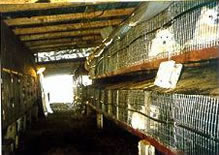 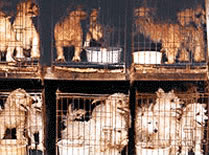
Pet
Store Puppy
I'm a little puppy,
so cuddly, sweet and small.
I live inside a cage you see at the Pet Store in the mall.
I'm not an only puppy, my sisters are all here.
My brothers too, except for Ralph who died 'cause he was scared.
It's lonely here
at nighttime when all the lights go dark,
We tremble in our cages and we whimper and we bark.
But no one comes to hold us or pet our fears away,
We sit all night in terror 'till the store opens the next
day.
We don't remember
mama, left so far behind.
She did the best she could for us till a Man said, "It
is time."
He crammed us all in cages too small for us, you see,
We rode for hours; we could not help but lay in poop and pee.
And now we sit
in the Pet Store where kids come taunt and squeeze,
They do not hear our whimpers or understand our pleas.
We're miserable and it's scary here; we all would rather die.
But since we don't, we do our best to run away and hide.
I know you think
my story too sad to leave me be.
You want to take me home with you, a happy little puppy.
But please, though it is fearful to live here against our
will,
If you take me, that leaves a spot another pup will fill.
You can stop our
suffering but not by taking us home.
You must be strong and leave us here, unsold and all alone
For if you do not take me, then another pup won't come,
And maybe he will not be shipped so far away from home.
Though some of
us may not survive the cycle 'ere it falls,
If we don't sell, they will not need more puppies in these
halls.
And if they need no puppies, then the Man will not bring more.
Eventually it can all stop! You CAN close the door.
So when you see
a puppy face so sad and sweet and small,
In a cage at the Pet Store at your neighborhood shopping mall,
The best thing you can do for him is leave him sitting there.
That is the best way you can tell all dogs how much you care.
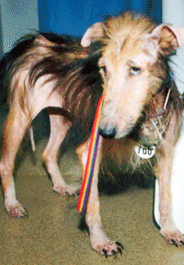
"Before" & "After"
Photos of a rescued Puppy Mill dog.
Actual Interview with an Ex-Pet Store Employee
I used to work for 'x corporation' and also
for 'y corporation' (names available upon private request).
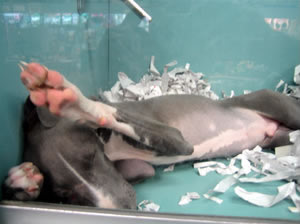 The puppies are all from mills in the south and the western
states. They came in shipped 6 to a crate that was the size
for one, two at the most. Covered in feces and filth sometimes
one or two would be dead. Some were pulled from their mothers
at 4 weeks so that by the time they were shipped to the stores
they would be 6 weeks old. Puppies came to the store that
had hardly any teeth and couldn't eat the food given to them.
These pups are also fed a minimal amount of food so that the
sales personnel are selling dogs and not spending their time
cleaning cages. 1/4 cup of food per day per dog only! We were
trained to sell sick puppies by showing how calm (sick) they
were. Many puppies died within days of reaching the store
or were so sick and malnourished that they died within days
of being bought. The store has no motivation to correct this
because they get "CREDIT" for all puppies that die.
ALL stores that sell puppies work this way. They buy a puppy
for no more than $100 usually closer to $60 and sell it with
worthless AKC papers for $600 or more. The customer will not
get their money back if the dog dies or becomes ill but must
take a credit for another puppy. The warrantee always states
this in very clever ways. Stores will not spend $100 in vet
bills for a $60 pup so they get minimal or no vet care. Once
stores stop selling puppies the mills will die out too. AKC
also benefits by this bogus trade in hundreds of thousands
of dollars in worthless AKC registration applications. Most
puppies are not even of pet quality and harbor birth defects
and other deformities. The puppy mills exist to feed
the pet store chains. They are connected and something must
be done on both ends. This is a multi million dollar industry
rooted in death and suffering. The puppies are all from mills in the south and the western
states. They came in shipped 6 to a crate that was the size
for one, two at the most. Covered in feces and filth sometimes
one or two would be dead. Some were pulled from their mothers
at 4 weeks so that by the time they were shipped to the stores
they would be 6 weeks old. Puppies came to the store that
had hardly any teeth and couldn't eat the food given to them.
These pups are also fed a minimal amount of food so that the
sales personnel are selling dogs and not spending their time
cleaning cages. 1/4 cup of food per day per dog only! We were
trained to sell sick puppies by showing how calm (sick) they
were. Many puppies died within days of reaching the store
or were so sick and malnourished that they died within days
of being bought. The store has no motivation to correct this
because they get "CREDIT" for all puppies that die.
ALL stores that sell puppies work this way. They buy a puppy
for no more than $100 usually closer to $60 and sell it with
worthless AKC papers for $600 or more. The customer will not
get their money back if the dog dies or becomes ill but must
take a credit for another puppy. The warrantee always states
this in very clever ways. Stores will not spend $100 in vet
bills for a $60 pup so they get minimal or no vet care. Once
stores stop selling puppies the mills will die out too. AKC
also benefits by this bogus trade in hundreds of thousands
of dollars in worthless AKC registration applications. Most
puppies are not even of pet quality and harbor birth defects
and other deformities. The puppy mills exist to feed
the pet store chains. They are connected and something must
be done on both ends. This is a multi million dollar industry
rooted in death and suffering.
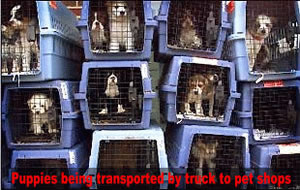
I thought it was the greatest job in the world
until I got a good look at the behind the scenes at the business
end. The day I quit was the day that a pug puppy died from
collapsed lungs in my arms as I took it to a vet, on my own
without the stores permission. The dog came in apparently
healthy but five days later started coughing and had a nasal
discharge. The pup was pulled from out front and put out back,
out of view. Out back it was also about 60 degrees or less.
The pup then developed severe diahreah (excuse the spelling).
On the managers orders the pup was to be given no food or
water. His belief was that without water and food it couldn't
have the runs. Two days later the dog was so dehydrated that
it could no longer stand and when you pulled the skin up on
its neck it stayed that way. Now the manager took an IV needle
and put about a cup of fluid under the pups skin on the neck.
The pup lay there rasping and gasping and wheezing( it had
received no medication up until this point) and when the manager
left for the day I took the dog to the vet. It was dead before
we got there and the vet said it's lungs had collapsed. The
manager was furious that I took the dog to a vet because he
did not need a vet to see the condition of the dog. I quit
after that because so many had died and would continue to
die for a buck. The sales people (myself included) are sent
to training seminars on "How to sell a puppy". Basically,
when you see someone looking at a puppy you go get it, and
without asking, put the puppy in their arms. Then you either
back off and force them to stay with the puppy for as long
as possible or you lock them in a little room with the pup.
Either way, afterwards, you make yourself scarce until they
have sold themselves on bringing the dog home. It is not an
accident, the sales people are trained to do this. We are
also trained to make a list for the potential customer on
why it is good to have a puppy from the store.We think of
every little thing and write it down. Then we make a list
of all the negatives and we do not help the customer think
of any at all. Guaranteed the "plus" list is much
much longer. I used to work as a Vet assistant before I took
this job. When I saw the conditions that the pups were in
and how they were handled I thought that I could help the
store to be better. What I found instead was an animal nightmare
and that they had it set up just the way they wanted. I saw
papers fabricated and medical histories falsified. The customers
would ask about a puppy that they had seen a day or two before
and now was missing (because it died or was going to). The
standard answer was, and still is, "Oh, he has been sold
and has gone to a new home". Medications are not done
by a vet but by the sale people and store workers themselves.
Mostly older teens and young people trying their first job.
They can not be expected to know what they are doing or how
to care for a sick animal properly. Anyway they are not allowed
to because they have to be out on the floor selling the puppies
. You get paid on a commission basis and the more pups you
sell the more you make. For these reasons, and more, I don't
mind at all if anyone else sees this. I only wish I still
had the paperwork from the 'x corporation' on selling and
dog care to give to someone...
"I
too was very excited when I got a job at the mall pet store
in college. Doctors Pet Center it was called. I only worked
there about 6 weeks. I couldn't stand the abuse of all those
animals. There was a kitten that had gotten too old and we
couldn't sell. I was going to take it home but the manager
decided she would "put it out of it's misery" as
she put it. (Slammed it against the wall.) I walked out of
work that day and never went back... They also kept all sorts
of animals that died in the refrigerator in the back office.
I opened the door one time to put my lunch in. Needless to
say I was totally grossed out... Thank you for putting this
information on your site for all to see. Hopefully I will
be able to get the puppy that I have been wanting, but I refuse
to help any mill or unethical breeder to do so. I just wanted
you to know that your info on pet stores is appreciated."
Bonham, Texas
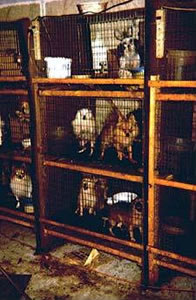 Today
the average puppy mill will house between 75 and 150 breeding
animals, most housed in hutch-style cages with wire floors.
The fecal matter drops to the ground below and waste accumulates
beneath the cage, providing a haven for flies and other vermin.
Even with fairly prompt removal of waste, the ground becomes
permeated with stench as the urine cannot be raked away. Dogs
housed in indoor facilities endure an equally deplorable existence
with ammonia vapors and odors permeating poorly ventilated
buildings. Rodents, flies and other pests plague the animals
almost constantly. Solid surfaces are supposed to protect
the legs of puppies; however, as they mature and scout out
their surroundings, feet and legs often fall through wire
floors. The resulting injuries compound their misery. Their
soft coats of fur become soiled with the fecal matter that
didn't drop through the cage, adding insult to injury. Today
the average puppy mill will house between 75 and 150 breeding
animals, most housed in hutch-style cages with wire floors.
The fecal matter drops to the ground below and waste accumulates
beneath the cage, providing a haven for flies and other vermin.
Even with fairly prompt removal of waste, the ground becomes
permeated with stench as the urine cannot be raked away. Dogs
housed in indoor facilities endure an equally deplorable existence
with ammonia vapors and odors permeating poorly ventilated
buildings. Rodents, flies and other pests plague the animals
almost constantly. Solid surfaces are supposed to protect
the legs of puppies; however, as they mature and scout out
their surroundings, feet and legs often fall through wire
floors. The resulting injuries compound their misery. Their
soft coats of fur become soiled with the fecal matter that
didn't drop through the cage, adding insult to injury.
At
8 weeks of age puppies are "harvested" and cleaned
up for the trip to the broker. They are bathed to clean up
feces and odors they have endured during their brief lives
in the puppy mill. Pus is wiped from their sad and scared
eyes just before they are shoved into whatever is convenient
– with any luck an approved shipping container. Some
will perish, and others will be rejected by the broker only
to be held back for breeding stock. Many others will be killed
for their lack of monetary value and some may even be sold
for research. The survivors can be seen at your local pet
store, but the emotional scars and irresponsible animal husbandry
can bring misery into your home instead of anticipated joy.
If
you have any compassion at all for the animals bred and raised
under these miserable conditions, stay out of pet stores.
Each puppy purchased from a pet store serves an industry with
no conscience and virtually no enforcement by USDA. Thousands
of unwanted animals of all ages and breeds are euthanized
at shelters every day. Adopt and spay or neuter a shelter
animal or rescued companion animal, and do your part to help
end the plight of unseen thousands housed in puppy mills throughout
the country.
As modern consumers, we equate a large inventory and broad
selection with a satisfactory shopping experience. But with
puppies and other pets, just the opposite is true.
Breeding
healthy and well adjusted puppies is a time and energy intensive
endeavor. After testing the parents for genetic problems and
providing veterinary care for the puppies, breeding seldom
leads to lucrative profits. An ethical breeder breeds to improve
his or her “line,” and normally uses puppy sales
only to offset the costs of showing the parents.
The
puppy mill sales strategy, on the other hand, is to make it
difficult for prospective customers to go home empty-handed
... so they provide a large assortment of breeds. With pets,
a big selection is a danger signal! Be wary of any breeder
that breeds many breeds of dogs. In the long run, it’s
better to resist this appeal to your customary shopping sense.
Learn
about which breed or mix is right for you before you actually
go to look for your pup. An impulsive choice can lead to a
boatload of regrets later! Reserving a quality home raised
puppy of a particular breed can sometimes mean a several month
wait, but will pay huge dividends. For those who want to visit/view
a selection of dogs, but don’t want to support the puppy
mill industry, consider one of the wonderful pets available
at your local Humane Society.
Before
purchasing a puppy, consider these important questions:
Are
the puppies in a home environment with plenty of stimulation?
A puppy should have plenty of early experience in its future
habitat: the human home. A puppy that has been raised in a
kennel, cage, or barn will be under socialized to people and
to the sights and sounds of a normal household. Puppy mill
puppies are so under stimulated that, as adults, they may tremble
upon seeing a falling leaf or hearing a cupboard door click
shut. Look for a puppy who has been well-socialized to family
and visitors and that lives in an active area of the house.
Also, puppies should always have plenty of toys available.
Do
the puppies have access to a “potty area”?
Housebreaking is extremely difficult for puppies purchased
from puppy mills. Most spend their formative weeks in small
cages with wire bottoms that allow wastes to drop through
onto a tray. This teaches puppies that 1) it doesn’t
matter where they eliminate because they never have to step
in it, and 2) they can’t get far from the smell, so
they’d better learn to live with it. It destroys the
puppies natural instinct not eliminate in their bed and food
areas, as puppy mill pups have no other choice. The end result
is a puppy that can’t be housebroken using a crate (cages
are self cleaning!) and that doesn’t have any desire
to eliminate outside of its home turf (no use trying to escape
from that poop smell!), and thinks its just fine to mess anywhere.
On the other hand, puppies raised in a large pen in a kitchen
learn the difference between living areas and elimination
areas. This makes it very easy to teach indoor/outdoor discrimination
later.
Is
the mother of the puppies present?
Unscrupulous breeders may tell customers that the mother is
absent because “she’s protective” of the
puppies, or because the puppies are “being weaned.”
These could be simply excuses. In reality, the puppies’
mom might be kept in a filthy barn or basement with dozens
of other breeding dogs. Breeding stock animals are often caged
together, and parents’ names on puppy registration papers
may be no more than guesses.
By
the way, if the puppies’ mom is less than enthusiastic
about your approach, the pups themselves may grow up to treat
guests the same way. You don’t need the hassle of a
puppy that had a “protective” (i.e., fear aggressive)
mom! And as far as weaning is concerned, never consider buying
a puppy so young that it is just being weaned.
How
old are the parents?
Make sure the puppy’s parents were at least two years
old before being bred. This allows time for genetic or temperament
problems to be discovered before they are perpetuated.
Know
how to read the registration papers and pedigree.
If you are buying a purebred puppy, make sure that the breeder
lets you review the AKC or UKC registration papers. Puppy
mill puppies are often registered with official-sounding organizations
that are really mail order fakes. The Continental Kennel Club,
for instance, readily supplies “papers” for any
mixed or purebred puppy for a fee. BUT...do not be mislead
that the AKC doesn't register puppy mill pups ...BECAUSE THEY
DO!
Also
check the registration papers for the puppy's state of origin.
Although some respected breeders live there too, be cautious
of puppies bred in Kansas, Iowa or Missouri. These states
have huge puppy mill industries that ship puppies to local
middlemen.
We've
all seen them, noses pressed to the glass, eyes pleading for
somebody to take them home. So cute and cuddly that many a
rational person has made the impulsive decision to bring one
home, a few hundred dollars later. And inevitably, thousands
of dollars in veterinary bills later, the poor sucker finally
realizes that maybe buying that puppy wasn't such a grand
idea.
Right
idea, wrong place, unfortunately.
Every
single puppy sold from a pet store came from a puppy mill,
or an irresponsible backyard breeder. How can I make
such a blanket statement, tarring them all with the same brush?
Simply because there is not one single responsible breeder
out there who would allow one of his or her dogs to be marketed
out like regular merchandise to whomever can lay down the
cash.
This
is a fact, there is no debating this. Even though the pet
store workers may try to assure you that the dogs came from
a responsible breeder, it is simply not true.
Let's
look at what defines a responsible breeder:
A responsible breeder must know where their puppies are going.
A responsible breeder will interrogate the potential buyer
about their home, family, living arrangements, other people
that share their house, their past, and their future. Police
interrogations have nothing on a breeder trying to find the
best possible home for his or her dogs. One I spoke with a
few years ago sent a five page questionnaire, on top of the
fifty or so questions she asked me over the phone.
A
responsible breeder will sell with a contract.
When you buy from a responsible breeder you will be signing
a binding contract stating that if something (anything) happens,
to this dog the breeder is the first to be told. This may
seem a little extreme, but there is a very legitimate reason
behind this. If your new dog develops hip dysplasia four or
five years down the road, she'll know to pull the parents
from the breeding line.
You
sign that if something happens to you, and you can no longer
care for your dog, she will be notified, so she may take the
dog back into her care or find it a new home.
You agree to spay or neuter your new pet as soon as possible
to help prevent unwanted litters if your dog was bought as
a companion.
You agree to abide by any other terms and conditions set forth
in the contract. You agree to be a responsible owner for the
pup she is entrusting you with.
As daunting as this is, if you think this over, you will realize
that she has done this to protect her dogs. Most people have
no trouble signing these contracts with a clear conscience.
A responsible breeder will take back into her care, any dog
at any time that has been bred from her breeding lines. Quite
often even dogs that were not.
A responsible breeder will do her very best to make sure that
none of her dogs ever end up in a shelter.
A responsible breeder can guarantee your new dog's freedom
from genetic diseases and defects for life, knowing that she
has done the very best to breed best possible parent to the
best possible parent and both were free from genetic problems.
Can
ANY pet store say the same thing?
Puppy
Mills: Behind the Scenes.
How
many times have we seen those adorable furry faces pressed
up against a pet store window? As tempting as it is to take
them, such an act fuels the puppy mill business, sentencing
more dogs to lives of misery, and usually brings the new owner
years of heavy vet bills and heartache. Where do pet store
puppies come from? The truth is horrifying.
It
was summer when I visited puppy mills in Lancaster County,
Pennsylvania. In the last few years, the area has become a
hub for large scale commercial dog breeding operations. And
although the Midwest still ranks as containing the highest
number of dog breeding operations, the concentration of puppy
mills in Lancaster County is unparalleled.
Accompanying
me was a Humane Society of the United States investigator
who had monitored the Pennsylvania mills for years. He knew
the county well, and had seen not only the proliferation of
puppy mills in the area, but at the same time, the increased
press and public attention in their operations.
Driving
through the pastoral landscape, it seemed impossible that
animal suffering could exist amidst such beauty. This illusion
was quickly shattered with my first view of a puppy mill.
For years, I had seen and studied photos of infamous facilities,
but nothing prepared me for seeing the real thing with my
own eyes.
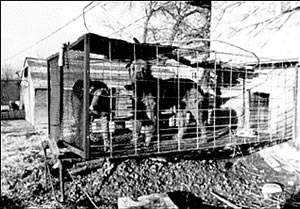 We
approached a farmhouse from the road and turned onto a muddy
lane. Rounding the corner, we didn't even have to get out
of the truck to see or hear what awaited us. Rows of dilapidated
cages were lined up outside a barn. Stopping the truck, my
throat constricted with shock. Dogs were crammed three or
more to a small cage which were elevated over mounds of feces.
Matted fur covered their eyes as they rushed towards the front
of their cages, barking at uninvited visitors. Their plight
was so dramatically different than the dogs I knew, the dogs
who lie lazily in afternoon sun, waiting for their next meal
or walk. No, these dogs were here for a purpose and only one
purpose: to make money. We
approached a farmhouse from the road and turned onto a muddy
lane. Rounding the corner, we didn't even have to get out
of the truck to see or hear what awaited us. Rows of dilapidated
cages were lined up outside a barn. Stopping the truck, my
throat constricted with shock. Dogs were crammed three or
more to a small cage which were elevated over mounds of feces.
Matted fur covered their eyes as they rushed towards the front
of their cages, barking at uninvited visitors. Their plight
was so dramatically different than the dogs I knew, the dogs
who lie lazily in afternoon sun, waiting for their next meal
or walk. No, these dogs were here for a purpose and only one
purpose: to make money.
We
saw many mills that day. Posing as buyers, we were able to
handle and examine some of the puppies. Many seemed sickly,
disoriented, and underweight. And when we were allowed to
see their mothers, or sneaked onto a farm to view the conditions,
the hopelessness of their lives weighed on me like a heavy
load that rests on my shoulders even to this day.
Dogs
hold a special place in our hearts. Domesticated thousands
of years ago, they were chosen to be our protectors, companions,
and best friends. And although we have betrayed our responsibility
towards them in many ways, none is so distressing or disturbing
as the puppy mill.
The
term "puppy mill," coined in the mid-to-late sixties
to describe large scale commercial dog breeding facilities,
has only recently arrived in the mainstream vernacular. It
is a term that some claim is sensational and manipulative.
The word "mill" refers to an operation that churns
out dogs in mass, using female dogs as nothing more than breeding
machines. The term conjures images of dogs crowded in wire
cages, living in their own wastes, shivering from the cold,
or baking in the heat. Tragically, this vision is not far
from reality. Most people, not just those interested in animal
protection, are shocked when confronted with the bleak images
of dogs housed and bred in puppy mills. But in the 5,000 puppy
mills found across the country, thousands of dogs are bred
and raised for profit, valued not for their companionship
or loyalty, but for the cold hard cash they bring.
Many
consumers possess an image of puppies at a family farm, lovingly
raised and cared for. Others may not even think about where
a pet store puppy comes from. Drawn to a pet store window
by a bin of wriggling puppies, the furthest thing from a customer's
mind is the origin of these cute bundles of fur. But by buying
a puppy, often for a price of $500 or more, the consumer is
unknowingly supporting a cycle of abuse that begins at the
puppy mill.
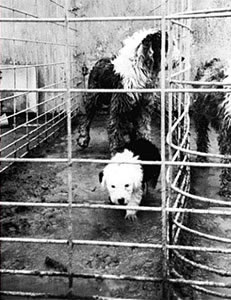 What
the consumer can't see is the puppy's mother, imprisoned miles
away, pregnant again, her body being used to produce more
money-making puppies. Starting at six months, she is bred
every heat cycle. She is often weak, malnourished, and dehydrated.
Rarely, if ever, is she provided with veterinary care. She
cannot maintain her productivity past her fourth or fifth
year. After that, she is nothing more than a drain on the
mill's operation and must be disposed of. If she's lucky,
she'll be humanely euthanized. More often than not, she will
be shot or bludgeoned to death. Discarded, her wasted body
will lie forgotten in a local landfill or garbage dump. What
the consumer can't see is the puppy's mother, imprisoned miles
away, pregnant again, her body being used to produce more
money-making puppies. Starting at six months, she is bred
every heat cycle. She is often weak, malnourished, and dehydrated.
Rarely, if ever, is she provided with veterinary care. She
cannot maintain her productivity past her fourth or fifth
year. After that, she is nothing more than a drain on the
mill's operation and must be disposed of. If she's lucky,
she'll be humanely euthanized. More often than not, she will
be shot or bludgeoned to death. Discarded, her wasted body
will lie forgotten in a local landfill or garbage dump.
This is the picture the pet stores will never show. And until
recently, the ugly truth of puppy mills has been hidden. But
when problems with many of the puppies bought at pet stores
across the country began to surface, consumers and animal
lovers alike began asking hard questions. Puppies with seizures,
parasites, infections, bacteria, and behavioral problems were
being seen far too often to be merely coincidental.
Puppy
mills and the pet store industry have begun to feel this scrutiny.
They insist that it doesn't make good business sense to sell
sick puppies or house breeding females in less than humane
conditions. But evidence gained after years of documentation
and investigation directly conflicts with these assertions.
In addition, those small scale breeders who do treat their
animals humanely, who raise them in their homes or in small,
cleanly kept kennels, do not usually make a profit off their
dogs. It is virtually impossible to breed in a humane fashion
and make money at the same time. Although a pet store may
sell a puppy for $500 or more dollars, most commercial breeders
can only get around $35 per dog from a broker who in turns
sells to the pet store for around $75. In order to make a
profit and cover costs, corners must be cut, and puppies must
be churned out at a furious rate. The cut corners are the
animals themselves: their housing, their health, their cleanliness.
Inherent in the profit-making mills is the sacrifice of humane
standards in order to make a profit.
What
protection, if any, do these dogs and their puppies have?
On the state level, puppy "lemon laws," existing
in a handful of states including New Jersey and California,
seek to offer consumers protection against buying sick puppies.
Although these laws do chip away at the production of sick
puppies, they do not address the inherent problem of the whole
system: the selling of dogs for profit.
The
federal level offers even less hope. The current system not
only allows the continuation of a business that makes money
off the backs of dogs, but fails in its responsibility to
provide even a basic quality of life for dogs in puppy mills.
Originally passed in 1966, the federal Animal Welfare Act
was amended in 1970 to include in its provisions the oversight
of large scale commercial dog breeding facilities. Regulations
were written with the intention of ensuring the proper care,
feeding, housing, and veterinary care for the thousands of
dogs found in puppy mills across the country. Mandated by
law to enforce these regulations is the United States Department
of Agriculture (USDA). But with a shortage of inspectors responsible
for overseeing these facilities, the agency has developed
a reputation for failing to meet its mandate.
Not
only have outsiders criticized the agency's ability to enforce
the Act in relation to puppy mills, but several internal reviews
have also illustrated the gross inadequacies existing at the
federal level. Recently, a damning internal review conducted
by the USDA's own office of the Inspector General of the agency's
South Central Regional Office offered a bleak picture. The
South Central Office, responsible for overseeing the majority
of this country's puppy mills, was found to be sorely lacking
in its ability to enforce the Animal Welfare Act. The report
found that the office failed to respond to complaints from
the public, failed to report a large number of blatant violations
of the law, and that supervisors told inspectors not only
where and when to inspect, but instructed their staff not
to write up too many violations of problematic facilities.
USDA Secretary Dan Glickman, embarrassed by the report's finding,
has demanded the development of an internal plan to respond
to the crisis within the agency.
The
USDA is also feeling the heat over the puppy mill issue from
members of Congress. After receiving constituent mail on puppy
mills, Congressman Glenn Poshard (D-Il) and Senator Rick Santorum
(R-PA), sprung to action. Working with The Humane Society
of the United States and other animal protection organizations,
they gathered over 100 signatures from members on both side
of Capitol Hill in a letter to Secretary Glickman expressing
concern about the problems found in puppy mills across the
country. Sent late last summer, the letter has caused anxiety
within the USDA.
This Spring, the agency will consider enacting stronger regulations
covering puppy mills as well as examining ways in which their
enforcement powers can be increased. Although any change in
the way puppy mills are regulated is an improvement, and stiffer
rules may even shut down or discourage potential operators
from opening a facility, the changes will not directly eliminate
the mills themselves. Until the demand for mass-produced pet
store puppies decreases, there will always be a buck to be
made in the production of dogs.
Rachel
A. Lamb is Director for Companion Animal Care at The Humane
Society of the United States (HSUS) in Washington, DC.
Puppy
Mills: What They Are and What You Can Do About Them.
The term “puppy mill” is used more and more frequently
today in the media, and often it has a different meaning depending
on who is using the term. It depends greatly on the writer’s
point of view as to what is considered to be “reputable”
dog breeding. For the purposes of this article, I consider
a reputable breeder to be someone who breeds only for the
betterment of the dog breed. Such a person very carefully
picks only the best champion stock for breeding, and screens
all breeding dogs for genetic defects. They very rarely make
a profit from their operation, and more often, take a loss.
Their primary motivation is to produce better dogs, which
are as close to the breed standard as possible.
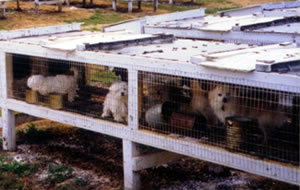 A
puppy miller, on the other hand, breeds only for profit. They
breed dogs without any consideration for genetic defects or
“faults” as defined by the breed standard. They
vary widely in their treatment of their breeding dogs and
puppies. The worst examples of puppy millers cruelly confine
their breeding animals in cramped, horribly unsanitary conditions
and give little or no veterinary care to them. These are the
places that are featured in the media, such as the Dateline
NBC show that aired this past April. Dogs that are rescued
from these conditions are often the worst we see in rescue,
in terms of physical and emotional health. There are also
puppy mills who keep their breeding dogs clean and vetted.
These millers at least offer some level of health to their
dogs, if not a loving “home” environment. How
is it that I can call all these people “puppy millers”
when their operations are so different? To me, the bottom
line of what is a mill and what isn’t is that a mill
produces purebred dogs for profit only and turns out poor
quality and/or sick puppies as a result. A
puppy miller, on the other hand, breeds only for profit. They
breed dogs without any consideration for genetic defects or
“faults” as defined by the breed standard. They
vary widely in their treatment of their breeding dogs and
puppies. The worst examples of puppy millers cruelly confine
their breeding animals in cramped, horribly unsanitary conditions
and give little or no veterinary care to them. These are the
places that are featured in the media, such as the Dateline
NBC show that aired this past April. Dogs that are rescued
from these conditions are often the worst we see in rescue,
in terms of physical and emotional health. There are also
puppy mills who keep their breeding dogs clean and vetted.
These millers at least offer some level of health to their
dogs, if not a loving “home” environment. How
is it that I can call all these people “puppy millers”
when their operations are so different? To me, the bottom
line of what is a mill and what isn’t is that a mill
produces purebred dogs for profit only and turns out poor
quality and/or sick puppies as a result.
So,
how do you know a puppy mill puppy when you see one? For one
thing, consider its source. Pet shops are a huge market for
puppy mill puppies. Just by looking at that cute little puppy
in the window you would never guess that his mother is locked
in a puppy mill cage in a Midwestern state, barely able to
keep herself alive, let alone care for her puppies. The pet
store may claim that they buy from only local breeders. That
may be true, but what they don’t tell you is that they
also buy from brokers who buy puppies from mills all over
the Midwest. Pet stores may also claim they only deal with
USDA licensed breeders. The fact is, being USDA licensed is
a huge red flag that the breeder is a puppy mill. Breeders
only have to get a USDA license if they sell wholesale to
pet shops or brokers. What’s even worse is that a USDA
license means practically nothing. There are only 65 USDA
inspectors to cover 11,000 facilities per year. Even when
an inspection is done and violations of the Animal Welfare
Act are found, generally nothing is done or there is only
a minimal fine. Kim Townsend of NoPuppyMills.com has excellent
information on her web site about just how shoddy the USDA
inspections really are.
In
the event a miller runs such a horrendous operation that he
loses his USDA license, there are still plenty of ways for
him to sell his puppies. Believe it or not, he can still sell
to pet shops, if he gives co-ownership of the puppies to the
pet shop owner. Then, the miller is not wholesaling his puppies;
he is retailing them. Retail puppy sales do not require USDA
license. Flea markets are another popular place for puppy
sales. They rely on the puppies’ cute faces to sell
themselves, and by the time the new owner figures out their
puppy is terribly sick, the seller is long gone. Many millers
advertise in their local newspapers also, or they may partner
with another person who will sell their mill puppies from
their home. Sometimes the miller is so bold as to list all
the breeds they have in one ad. Other times they will fool
you into thinking they only have one breed by running separate
ads for each breed. When you contact the people about their
ad, they may give you a reason why they will be out in your
area and offer to bring the puppy to you or meet you somewhere.
If you actually get to visit their home, they will only bring
out the breed you are interested in. You won’t be allowed
to see the parents, because the parents are either out back,
covered with filth and reeking of disease, or they aren’t
even there.
Another
tool of puppy millers to make their dogs sound well bred is
American Kennel Club (AKC) papers. The AKC is only a registry,
and as such, has no regulatory ability over breeding practices.
It exists to track the parentage of purebred dogs. Ever since
its inception, a breeder was on their honor to be honest about
the parentage of the puppies they produce. Mills were able
to register anything, even cross breeds, as purebred dogs.
An uneducated puppy buyer wouldn’t even know the difference.
Another common practice was bunching puppies together. The
AKC charges a fee per litter, not per puppy. If you have two
females of the same breed with litters at the same time, even
if the ages of the puppies are quite different, register them
as one litter and save a little money. Another common practice
was to add a few extra puppies to a litter so that you can
register puppies for your friend whose AKC privileges have
been revoked. Things are changing, now, however. The AKC has
now started requiring DNA testing for breeding dogs and puppies,
which increases the costs to the miller dramatically, and
vastly increases the chances of them getting caught for their
dirty dealings and losing AKC privileges. Does this deter
the millers? Not really. They just turn to different registries,
like the Continental Kennel Club (CKC), America’s Pet
Registry (APR), and others. Purebred papers from these sources
are not worth the paper they’re printed on. Millers
don’t even have to prove they own the dogs they bred,
or that they are the breed they claim. These registries will
even register mixed breeds, like cock-a-poos!
What
does all this mean to you? A puppy that comes down with distemper
or parvo is your worst nightmare come true. Your precious
new puppy may rack up vet bills totaling in the thousands,
and still end up dying. It’s only common sense to realize
that puppy mills, which care only about profit, may skip costly
vaccinations that could have prevented your puppy’s
death. Health certificates for the puppies can be easily forged
by a vet who is in alliance with millers. Even if the puppy
did receive its shots before it left the breeder, pet stores
rarely will give any veterinary care to the puppies they have
after they receive them. People who have worked in pet shops
speak of “dying rooms” where the sick and dying
puppies are put until they have died and can be thrown like
so much garbage. They certainly couldn’t keep that sick
puppy out in full view of the public.
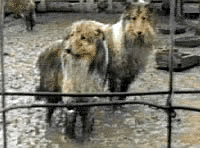 Even
if the mill puppy doesn’t get sick right away, there
may be some genetic disease lurking within his body. Which
is more tragic, an 8 week old puppy who dies of parvo, or
a 1 year old dog who dies from a hole in his heart? How would
you feel if the dog you dearly love was killed or struck down
with a painful or debilitating disease in the prime of life?
You’d probably be pretty angry about the poor breeding
practices that produced him, and well you should be. It’s
true, not every genetic disease can be screened for, but a
responsible breeder will make every attempt to identify these
problems if possible. They will either certify their puppies
to be free from genetic defect or they will wait until their
dogs are several years old before breeding them, so that late
onset diseases will have appeared by then. Another group of
genetic diseases are associated with so-called “rare”
colors and patterns. It’s a known fact that blues and
isabellas have skin and coat problems. Millers breed these
colors because they can increase their profits if they convince
buyers that the pups are rare. This is an area where the public
can exercise a little common sense. If a color is “rare”,
there is probably a reason why. Either it is an improper color
for the breed and as such is disqualified from showing, or
it has health problems associated with it that responsible
breeders do not want to propagate. The double dapple pattern
is another example of this. Double dapples are frequently
born with congenital blindness and/or deafness. The trend
now among mills is to produce puppies that have two patterns,
as in dappled piebalds. This practice is very detrimental
to the breed since it makes the patterns difficult to track.
AKC only allows one pattern to be chosen for a pup, so years
down the road there may be recessive genes that pop up without
warning. Since piebald and double dapple both produce white
in the coat, and double dapples can have such serious congenital
defects, it is important to keep them separate or it may not
be possible to tell which pattern an offspring has. Even
if the mill puppy doesn’t get sick right away, there
may be some genetic disease lurking within his body. Which
is more tragic, an 8 week old puppy who dies of parvo, or
a 1 year old dog who dies from a hole in his heart? How would
you feel if the dog you dearly love was killed or struck down
with a painful or debilitating disease in the prime of life?
You’d probably be pretty angry about the poor breeding
practices that produced him, and well you should be. It’s
true, not every genetic disease can be screened for, but a
responsible breeder will make every attempt to identify these
problems if possible. They will either certify their puppies
to be free from genetic defect or they will wait until their
dogs are several years old before breeding them, so that late
onset diseases will have appeared by then. Another group of
genetic diseases are associated with so-called “rare”
colors and patterns. It’s a known fact that blues and
isabellas have skin and coat problems. Millers breed these
colors because they can increase their profits if they convince
buyers that the pups are rare. This is an area where the public
can exercise a little common sense. If a color is “rare”,
there is probably a reason why. Either it is an improper color
for the breed and as such is disqualified from showing, or
it has health problems associated with it that responsible
breeders do not want to propagate. The double dapple pattern
is another example of this. Double dapples are frequently
born with congenital blindness and/or deafness. The trend
now among mills is to produce puppies that have two patterns,
as in dappled piebalds. This practice is very detrimental
to the breed since it makes the patterns difficult to track.
AKC only allows one pattern to be chosen for a pup, so years
down the road there may be recessive genes that pop up without
warning. Since piebald and double dapple both produce white
in the coat, and double dapples can have such serious congenital
defects, it is important to keep them separate or it may not
be possible to tell which pattern an offspring has.
Let’s
assume now that your pet store or flea market puppy doesn’t
have any contagious disease or genetic defect. You might think
then that your puppy is just as well off as if it had come
from a responsible breeder. Sadly, this is not true. In addition
to the physical health problems of puppies coming from mills,
there are emotional problems very often too. These puppies
are raised with very little or no human contact until they
are suddenly yanked away from their mothers and sold. They
are usually sold at a very young age because keeping the puppies
additional weeks would eat into the miller’s profits.
Without proper socialization during the critical period of
3-10 weeks of age, the puppies may become withdrawn and distrustful
of people. During this critical period, it is absolutely essential
that the puppies receive contact with people if they are going
to make good pets later on. Without this socialization, the
puppies will be fearful of people and will remain that way
throughout their life. Many times puppies that are raised
in isolation from people will never be able to bond with a
human. Their fear of people can manifest itself in all manner
of neurotic behaviors such as fear biting and submissive urination.
Long term isolation from other dogs is also a reason why so
many dogs develop obsessive behaviors like spinning and pacing.
In rescue we see many adult dogs that have lived their entire
lives in puppy mills. They are the worst behavioral cases
we get. Occasionally, their fears are so deep-rooted that
there is nothing that can be done to cure it. To me, this
is the worst part of the puppy mill industry. The dogs are
treated as a commodity rather than as a cherished pet. They
merely exist rather than having a life. They will never know
the joy of chasing a ball, or lying on a sofa watching TV.
They’ll never have any “goforarides” or
plush squeaky toys to shred. They suffer and die without ever
knowing love.
In
order to stop the mills, several things about our society
must change. The first thing and most important thing, is
the USDA must be cleaned up. There need to be many more inspectors
and those inspectors should actually go out and enforce the
Animal Welfare Act like they are supposed to do. No more “warnings”
for serious violations that go unchanged for years on end!
We need to have a zero tolerance policy for animal cruelty
in this country! Not just for the puppy mills, but for all
America. Our society has let animal abusers get away with
their crimes with nothing but a slap on the wrist for far
too long. We need laws passed in every state that makes abusing
an animal a felony. Write your Senators and Representatives
about your outrage at the horrible animal abuse that is allowed
to happen in this country. Make your voice be heard!
Second,
inform everyone you now about buying from responsible breeders.
Tell them that to find a responsible breeder, they should
ask vets, go to dog shows, or ask friends for referrals. Explain
to them that a responsible breeder will want to check them
out as thoroughly as they check out the breeder. A breeder
who doesn’t care where their puppy is going is either
a mill or no better than one. A responsible breeder will offer
health guarantees with their puppies. They will place their
puppies on a contract that states the buyer will return the
puppy to them if they can’t keep it. They will do everything
they can to ensure that the buyer and puppy are completely
happy with each other.
Third,
boycott pet stores that sell puppies. We need to send a clear
message to pet store owners that we are fed up with the large
scale abuse of dogs and we want it stopped! Unfortunately,
just taking away the American market for mill puppies is not
enough to stop them. The mills will simply divert their business
to foreign markets. That’s why it is absolutely essential
to changing the laws. There are many organizations in existence
who are dedicated to this task. See the links section below
to visit their sites and get involved! The only way the puppy
mills will ever be stopped is if all Americans make it clear
that we will not tolerate this any longer! 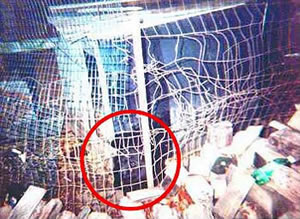
Is
this the way a dog should have to live it's life?
No
love, no warmth, no kindness and only considered a commodity.
Think of all the dogs like this one below and tell yourself
you can look the other way. Think of him or her when you see
that puppy in the pet shop window and how miserable and unhappy
his or her life truly is. Think of this face and get involved.
This could be your puppy's mother.
Copyright
© Michelle Wray 2000, written in collaboration with DOG
Magazine.
Reposting or copies of this article must credit the author
and show copyright.

• Home • Our IGs • Available • Litters • Sales Policies • Partnership Program • Testimonials • Photo Gallery •
• Just A Little Faith! • IG Care & Info • Pet Store Pups • How Could You • IG Rescue • IG Links •
• About Time Cane Corso •
|